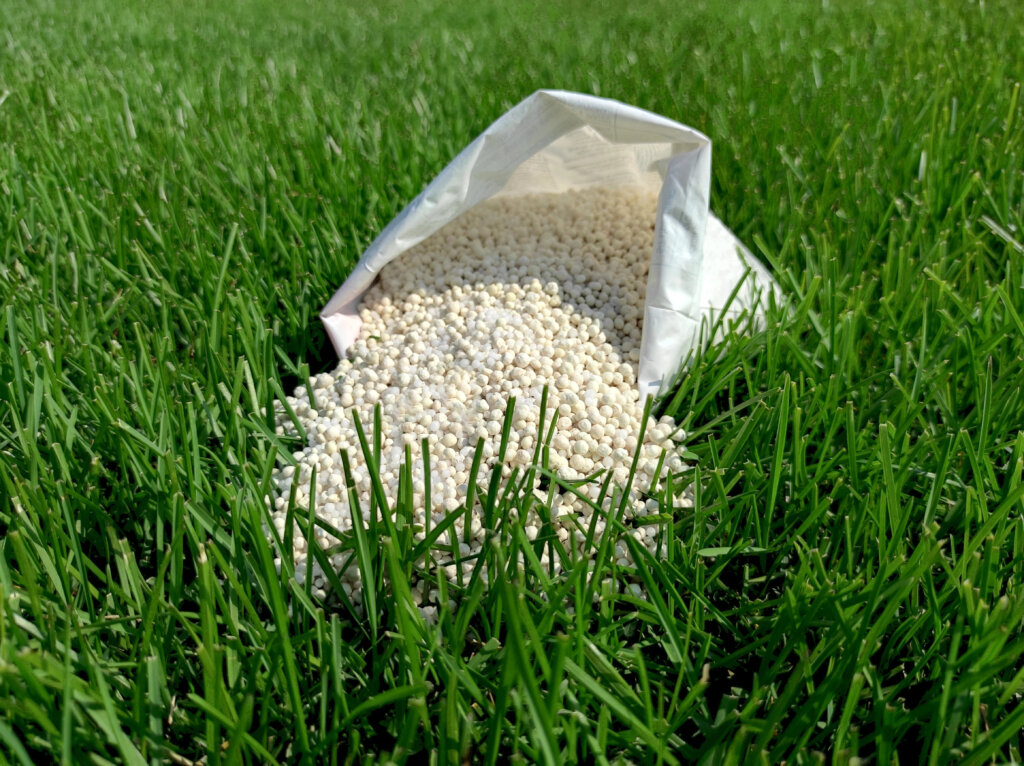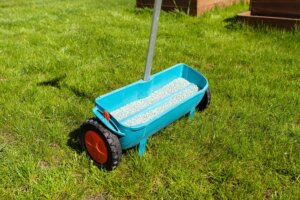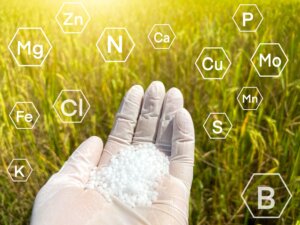Ever wondered what those three bold numbers on a fertilizer bag really mean? In Pennsylvania, understanding fertilizer numbers is the secret to turning patchy grass into a healthy, vibrant lawn that thrives through every season.
TL;DR: What You Need To Know
- Fertilizer numbers like 10-10-10 show the N-P-K ratio—how much nitrogen, phosphorus, and potassium your lawn gets. These numbers represent the main nutrients, while other ingredients provide trace minerals and soil support.
- Nitrogen boosts green growth, phosphorus builds strong roots, and potassium helps with drought and disease resistance.
- Labels tell you if it’s organic or synthetic, the nutrient sources, and whether it’s slow- or fast-release.
- In Pennsylvania, slow-release fertilizers keep lawns fed steadily through seasonal changes.
- Popular mixes: 10-10-10 for balance, 20-10-10 for quick green-up, 5-10-10 for roots and flowers, 15-0-15 for mature lawns.
- A soil test ensures your N-P-K matches your lawn’s needs.
What Do Fertilizer Numbers Mean?
If you’ve ever picked up a bag of fertilizer and noticed three bold numbers, like 10-10-10, you’ve seen the fertilizer numbers. These indicate the proportion of nitrogen (N), phosphorus (P), and potassium (K) by weight, commonly referred to as the N-P-K ratio.
For example, a 10-10-10 fertilizer contains 10% nitrogen, 10% phosphorus, and 10% potassium. The remaining 70% is made up of micronutrients and filler materials that help spread nutrients evenly across the soil.
These three macronutrients are the building blocks of healthy plant growth and overall plant health:
- Nitrogen (N): Stimulates lush leaf growth and rich green color.
- Phosphorus (P): Promotes root growth and flower or fruit production.
- Potassium (K): Strengthens disease resistance, cold hardiness, and drought tolerance.
You can dive deeper into how each nutrient works in Terra’s Nitrogen, Phosphorus, and Potassium Lawn Fertilizer Guide.
Reading a Fertilizer Label
Every fertilizer label tells you more than just the N-P-K numbers. It also includes:
- Fertilizer formulation: Whether it’s dry fertilizer or liquid fertilizer, organic or synthetic.
- Nutrient source: Compounds like potassium sulfate, phosphate, or ammonium nitrate.
- Slow-release details: Indicates how long nutrients feed the soil.
In Pennsylvania’s variable climate—from humid summers to frosty winters—choosing a slow-release fertilizer helps sustain healthy plant roots over time, especially in suburban lawns from West Chester to King of Prussia.
For best results, partner with a local expert. Terra Lawn Care’s Lawn Fertilization Services ensure your soil and grass receive the right nutrient balance, season after season.
Understanding Fertilizer Numbers and the N-P-K Ratio
The N-P-K ratio on a fertilizer label shows the percentage of the three main nutrients: nitrogen, phosphorus, and potassium. Each is essential for plant growth and soil health. Here’s a quick look at what those three numbers mean in common fertilizer formulations:
| Fertilizer Example | Nutrient Balance & Purpose | Best Use Case |
|---|---|---|
| 10-10-10 | Equal concentrations of all three important nutrients (N, P, K) support balanced fertilizer analysis. | Ideal for general lawn health and garden maintenance. |
| 20-10-10 | Higher first number (nitrogen) boosts leaf growth and color; moderate phosphorus and potassium. | Best for fast green-up and early spring fertilizing. |
| 5-10-10 | Lower nitrogen with higher second and third numbers promotes root growth and fruit or seed formation. | Perfect for establishing new lawns, seeds, or fruit-bearing plants. |
| 15-0-15 | No phosphorus; nitrogen and potassium enhance stress resistance and disease defense. | Great for mature lawns with strong roots or phosphorus-rich soils. |
If your lawn’s soil test reveals a phosphorus deficiency, choose a mix like 10-20-10 to restore balance and improve soil structure naturally.
To explore more about how balanced fertilizer numbers impact plant and lawn performance, check out Terra’s detailed guide on 10-10-10 Fertilizer: The Power Trio for Balanced Plant Growth.
Organic vs. Synthetic Fertilizers

When comparing organic fertilizers (like compost or manure) with synthetic fertilizers (like Miracle-Gro or ammonium sulfate), the biggest difference is nutrient availability.
- Organic fertilizers, like compost or manure, release nutrients slowly, enriching soil microbes and improving structure. Research from the University of Maryland Extension shows that compost releases only about 5–10% of its nutrients each season, compared to up to 85% for fast-acting synthetic mixes.
- Synthetic fertilizers deliver nutrients quickly, which helps lawns green up faster, but can risk nutrient runoff if overused.
In Pennsylvania’s nutrient-sensitive soils, especially near waterways, Terra Lawn Care technicians balance both organic and synthetic blends to promote sustainable plant growth without harming the environment.
Why a Soil Test Matters
Before you fertilize, getting your soil tested through a local extension or professional lawn service makes a big difference. A test reveals your soil’s pH, nutrient deficiencies, and whether compounds like magnesium, iron, or zinc are lacking.
This ensures you’re not wasting money or damaging your lawn with the wrong fertilizer. Once you know your soil composition, Terra’s agronomist-led team can customize a plan based on your lawn’s nutrient profile. You can learn more or request service via Terra’s Contact Page.
5 Fertilizing Tips for Pennsylvania Lawns
- Apply fertilizer in early spring and fall when grass is actively growing.
- Avoid fertilizing right before heavy rainfall to reduce nutrient runoff.
- Use slow-release formulations to maintain consistent nutrient feeding.
- Keep a balanced N-P-K ratio (like 15-15-15) for year-round plant health.
- Work with a certified team—like Terra’s state-licensed technicians—who understand PA’s local soils and seasonal needs.
If you want to compare popular mixes, see how 15-15-15 fertilizer differs from other balanced blends in this guide: 15-15-15 Fertilizer: The Pro’s Guide to Balanced Plant Nutrition in Collegeville, PA.
Ready to upgrade your lawn’s nutrient balance?
Understanding fertilizer numbers is key to maintaining healthy, resilient lawns across Pennsylvania. The N-P-K ratio on your fertilizer bag determines how your grass grows—whether it’s greener leaves, stronger roots, or better stress resistance.
For expert guidance, trust Terra Lawn Care, a locally owned, family-operated company with more than 50 years of combined lawn care experience. Serving homeowners across the Tri-State area, Terra’s certified team crafts precise fertilization plans tailored to your soil, your grass, and your goals.
Explore Terra’s Service Area and schedule professional lawn fertilization today.
Frequently Asked Questions About Fertilizer Numbers
The best fertilizer numbers depend on what your soil needs most. For many Pennsylvania lawns, balanced mixes like 10-10-10 or 15-15-15 provide an even supply of minerals—nitrogen, phosphorus, and potassium—that keep plants green and strong. If your soil test shows a nitrogen shortage, a higher first number, like in 20-10-10 can help promote fast growth while still supporting healthy roots and drought tolerance.
30-10-10 fertilizer has a higher concentration of nitrogen, which stimulates lush leaf growth and deep green color. It’s often applied to cool-season grasses or agricultural turf that require strong top growth. Because it has less phosphorus and potassium, it’s best used when your soil already contains enough of those minerals and micronutrients like manganese or calcium.
You can use 28-0-3 fertilizer during the growing season once your lawn’s roots are established. This mix delivers nitrogen and potassium—essential for stress resistance and drought protection—while skipping phosphorus, which some Pennsylvania soils already have in abundance. Since the second number is zero, the formula focuses on above-ground growth and overall plant health.
20-20-20 fertilizer offers equal concentrations of nitrogen, phosphorus, and potassium, making it ideal for use in a garden or on plants that need balanced nutrition. It also contains small amounts of sulfur, carbon, and other trace minerals that support healthy root and leaf development. This mix is often measured in pounds for precise application and is especially valuable in agriculture or for container-grown plants that need steady nutrient levels.



